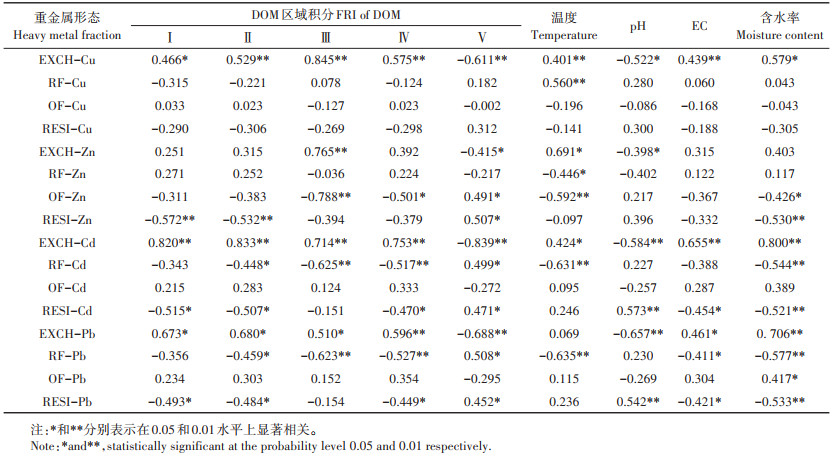2. 农业农村部资源循环利用技术与模式重点实验室, 北京 100125
2. Key Laboratory of Technology and Model for Cyclic Utilization from Agricultural Resources, Ministry of Agriculture and Rural Affairs, Beijing 100125, China
随着集约化、规模化养殖业的快速发展,Cu、Zn等微量重金属元素被广泛应用于饲料添加剂[1]。据统计,我国每年使用的微量元素添加剂为15万~18万t,而畜禽对微量重金属元素的利用率较低,大量重金属随粪便排出[2],如Cu和Zn随粪便排泄量占总摄入量的95%以上[3]。王飞等[4]对华北地区畜禽饲料和粪便的采样分析表明,生猪和肉牛饲料中重金属均存在超标现象,生猪饲料中Cu、Zn超标率为66.67%、80.00%,畜禽粪便中以Cu、Zn超标为主(参照德国腐熟堆肥标准),其中猪粪的Cu、Zn超标率分别高达100%、91.67%。贾武霞等[2]调研分析了北京市、山东省寿光市、湖南省岳阳市共104个规模化养殖场中畜禽粪便的重金属含量,发现猪粪中Cu、Zn的超标率分别达59.84%和95.08%。好氧发酵是实现畜禽粪便肥料化利用和重金属钝化的有效途径[5],发酵过程中有机物质降解形成的大分子腐殖质类物质与重金属结合,可降低重金属的活性和生物有效性[6]。水溶性有机物(DOM)可与重金属发生络合作用,降低重金属的迁移转化及生物有效性,其中富里酸(FA)和胡敏酸(HA)的变化是影响重金属迁移性和有效性的关键因素[7-8],HUANG等[9]的研究发现,畜禽粪便与玉米秸秆发酵过程DOM中的酚羟基和羧基对Cd和Cu的络合反应效果明显。温度、含水率、pH等发酵条件的变化,也会影响重金属的形态和活性。SHEN等[10]的研究发现,pH值与Cu的钝化效率呈正相关,初始含水率为65%时对Cu、Pb的钝化效率最佳。
为进一步提高好氧发酵重金属的钝化效率,将生物炭作为钝化材料,生物炭具有较大的比表面积、发达的孔隙结构、丰富的官能团和较高的矿质灰分,其可有效吸附固定重金属,提高微生物的多样性及丰富度,加快物料腐熟降解,促进腐殖质类物质对重金属的络合固定[11-13]。ZHOU等[14]在猪粪好氧发酵过程中添加木屑炭、小麦秸秆炭和腐植酸复合钝化剂后,Cu、Pb和Cd的钝化效率分别达到94.98%、65.55% 和68.78%。LI等[15]也发现添加生物炭后,猪粪中Cu、Zn的钝化效率明显提升,且发酵前后重金属形态变化与HA和FA密切相关。已有研究大多针对生物炭对好氧发酵前后重金属钝化效果和腐熟指标变化等,但对发酵过程中不同阶段理化特性、DOM组分变化及对重金属形态变化影响机制的研究较少。因此,本研究以猪粪和玉米秸秆为原料开展好氧发酵试验,并添加玉米秸秆生物炭,分析不同发酵阶段理化指标、DOM变化特征以及对重金属形态的影响机制,为生物炭在畜禽粪便好氧发酵过程中对重金属的高效快速钝化提供理论基础。
1 材料与方法 1.1 供试材料供试猪粪取自北京东华山沼气站;玉米秸秆取自北京顺义赵全营附近农田,秸秆粉碎至1 cm左右;生物炭为玉米秸秆生物炭,采用厌氧干馏热解技术,热解温度为450 ℃,BET比表面积为5.02 m2·g-1,平均孔径和孔容分别为7.43 nm和0.02 cm3·g-1。原料的理化性质如表 1所示,试验所用试剂均为优级纯。
|
|
表 1 发酵原料的理化性质 Table 1 Physical and chemical characteristics of the compost materials |
猪粪和玉米秸秆按质量比为18∶4充分混合均匀,调节C/N为25、含水率为65%~70%,添加不同比例的生物炭(以猪粪干物质量计,表 2),通风量为0.1 m3·min-1·m-3)。试验装置为密闭发酵反应器,容积为60 L。试验处理如表 2所示。分别在第1、3、5、8、12、16、20、30 d采集不同发酵阶段的物料,每次取发酵反应器上中下3部分样品共300 g左右,混合均匀,一部分鲜样冷藏后用于含水率、pH、电导率、E4/E6(465 nm和665 nm波长下分光光度计测定的吸光值的比值)、种子发芽率指数测定;另一部分冻干后粉碎过筛,用于重金属(Cu、Zn、Pb、Cd)形态、总量及DOM组分测定。
|
|
表 2 好氧发酵试验处理 Table 2 Aerobic fermentation test treatment |
发酵温度:由发酵罐内的3个温度探头在线实时监测。
含水率:取10~25 g鲜样于铝盒中,105 ℃烘干8 h以上,用容重法测定鲜样含水率,重复3次。
重金属形态:采取改进的BCR法[16]提取后消解,采用电感耦合等离子质谱仪(ICP-MS,美国安捷伦)定量分析好氧发酵各阶段各重金属形态的含量。重金属各形态质量之和与国家标准土壤物质GBW07405(GSS-6)中重金属总量进行比较,Cu、Zn、Cd、Pb的回收率在84.61%~97.99%之间。
pH、电导率(EC)、种子发芽指数(GI)、E4/E6:鲜样与去离子水按固液比为1∶10(m∶V)混合后以200 r·min-1浸提1 h,离心过滤,测定上清液pH和EC。取上述10 mL滤液至培养皿,以去离子水作空白试验,将20粒油菜种子均匀放置后于25 ℃培养箱中培养72 h,测定种子发芽数量及根长,并计算GI。取上述过滤液稀释10倍后采用分光光度计(Hanon-i7,海能)分别在465 nm和665 nm波长下测定稀释液的吸光值,并计算其比值,即为E4/E6。
三维荧光:将冻干的发酵样品和去离子水按固液比为1∶10(m∶V)混合后,以200 r·min-1振荡浸提16 h,12 000 r·min-1离心20 min,然后过0.45 μm滤膜,将样品稀释至TOC仪测定浓度为6 mg·L-1备用[17]。采用荧光光度计(Cary Eclipse,美国安捷伦),发射(Emission)光谱波长从250~600 nm,2 nm增量,激发(Excitation)波长从200~500 nm,10 nm增量,激发和发射狭缝(Slit)宽度为5 nm,扫描速度(Scan control)为1 200 nm·min-1,光电倍增管(PMT)的电压设置为800 V。
1.4 数据处理GI(%)由公式(1)计算[18]:

|
(1) |
重金属不同形态分配率由公式(2)计算。采用可交换态发酵前后形态变化作为重金属钝化效果的指标,由公式(3)计算[13]:

|
(2) |

|
(3) |
荧光积分:将三维荧光数据导出,采用Origin 9.5计算光谱中激发/发射波长分别在200~250 nm/250~ 330 nm、200~250 nm/330~380 nm、200~250 nm/380~ 500 nm、250~280 nm/250~380 nm及250~400 nm/380~ 500 nm区域范围内的体积积分。
使用Microsoft Excel和Origin 9.5对数据进行处理并作图分析,统计分析采用数据分析软件SPSS 21.0,用Pearson相关分析系数法分析发酵物料理化性质与重金属形态间的相关性。
2 结果与讨论 2.1 好氧发酵腐熟度的变化特征温度是表征好氧发酵过程生物能量积累及腐熟效果的重要指标,T1、T2、T3和T4处理的温度变化曲线如图 1a所示。T1处理升温较快,发酵第2 d时达到高温55.1 ℃,其他3个处理在第6 d达到高温,其中T3和T4处理的最高温分别达到61.3 ℃和62.2 ℃,在第12 d翻堆后,T2和T4处理温度均有所上升,T4处理重新达到55 ℃,在第16 d再次翻堆后,4个处理的温度持续下降无再次升高,生物可降解物质消耗殆尽,堆肥进入腐熟阶段。各处理高温期(50~60 ℃)均持续5 d以上,可有效杀灭致病微生物,满足《畜禽粪便无害化处理技术规范》(GB/T 36195—2018)的要求。与T1处理相比,添加生物炭的处理未能快速升温,该结果与WANG等[19]加入磷酸盐和生物炭使堆体快速升温的结果不同,但在一定程度上提高了高温期温度,这与生物炭发达的孔隙结构为发酵过程中微生物提供充足的氧气,减少因水分蒸发而引起的热量损失有关。
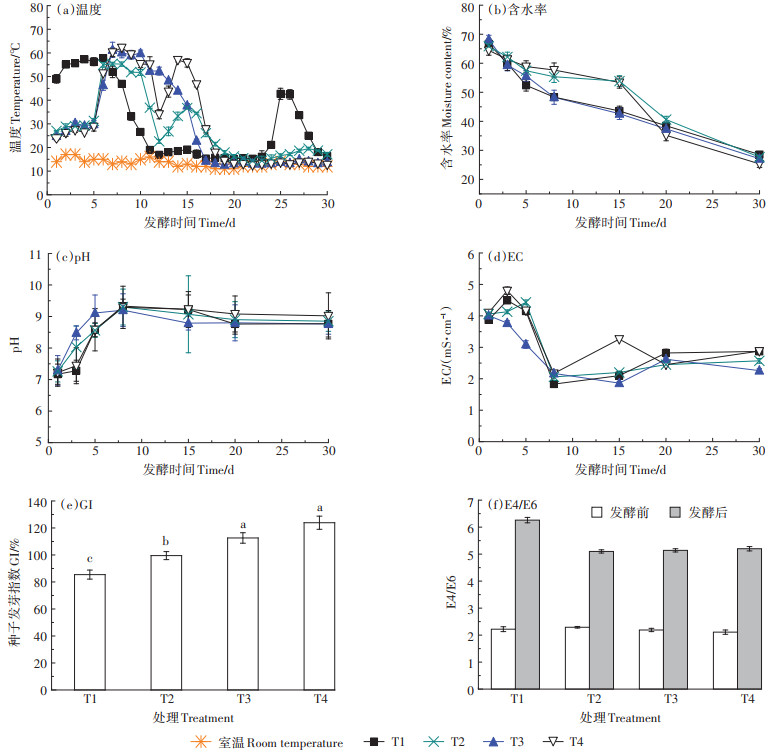
|
不同小写字母表示处理间在0.05水平差异显著 Different lowercase letters indicated significant difference among treatments at 0.05 level 图 1 不同处理腐熟度和理化性质的变化 Figure 1 Effects of different proportions of biochar on physicochemical properties of aerobic fermentation of swine manure |
含水率变化曲线如图 1b所示,在整个发酵周期内含水率呈不断下降趋势,其中T4处理含水率下降速度较慢,在发酵初期生物炭良好的孔隙结构吸收了部分水分,而后随着温度升高和有机质的降解,水分逐渐蒸发。pH变化如图 1c所示,在整个发酵周期内,pH呈现先上升后下降并逐渐稳定的趋势,由于发酵初期有机酸的生物降解、挥发以及氮的氨化使pH上升[20],但随着发酵过程中NH3挥发、H+释放和生物硝化反应的发生导致pH逐渐降低[21],至发酵结束pH稳定在8.5~9.5之间。添加生物炭有效提高了堆肥pH,这与LI等[22]的研究结果一致。EC整体呈现先上升后下降的趋势,在发酵初期,有机物迅速分解为铵、有机酸等可溶物,随着发酵进行,有机酸类物质转化为腐殖质类物质,导致EC降低[23],发酵结束时EC范围为2.26~2.87 mS·cm-1,均小于4 mS·cm-1,说明发酵后物料中各离子向稳定态转化,离子活性降低。图 1e为发酵后不同处理的GI,T1、T2、T3和T4处理的GI分别为85.1%、99.5%、112.5%和124%,受生物炭添加量的影响显著,说明生物炭可有效提高腐熟度[24]。E4/E6也在一定程度上表征好氧发酵产品的腐熟度,T1、T2、T3和T4的E4/E6由发酵前的5.10~6.26下降到2.11~2.29,其中T4最小,为2.11,说明羧基、羰基和酚羟基的含量升高,甲氧基和醇羟基的含量下降[25]。
好氧发酵前后元素含量变化如表 3所示,由于好氧发酵过程中脂质、脂肪化合物和木质素等有机物的降解[26],各处理C/N由发酵前的26.11~27.17下降至9.57~15.23,说明生物炭添加量对其影响显著。T值是好氧发酵最终物料C/N与初始物料C/N的比值[27],4组处理的T值均小于0.6,达到腐熟标准。植物必需的营养元素中N含量变化不明显,P、K含量均有不同程度的升高,其中P元素发酵后含量增长了1倍。
|
|
表 3 好氧发酵前后元素含量变化 Table 3 Changes in nutrient content before and after aerobic fermentation |
猪粪好氧发酵产生的DOM含有大量的苯环结构,因此在吸收一定的光能后会产生荧光,能够灵敏地反映物质演化特征[28-29],是研究好氧发酵有机物质转化的重要介质。图 2为发酵各阶段的三维荧光光谱(EEM),根据对应的激发和发射波长划分为5个区域,其中区Ⅰ来源于类色氨酸物质,区Ⅱ来源于类酪氨酸物质,区Ⅲ为类富里酸物质,区Ⅳ为可溶性微生物降解产物,区Ⅴ为类胡敏酸物质[30]。发酵初期(D1),各区荧光强度均较弱,其中T2和T4处理在区Ⅰ、区Ⅱ和区Ⅳ有荧光峰出现;升温期(D2)类腐殖质物质(区Ⅲ、区Ⅴ)开始增加,区Ⅱ荧光强度逐渐降低;T1和T2处理在高温期(D3)类腐殖质物质大量出现,区Ⅲ、区Ⅴ荧光明显增强,降温期(D4)与高温期(D3)各区域的荧光强度变化不明显;腐熟期(D5)后类胡敏酸物质明显增加。
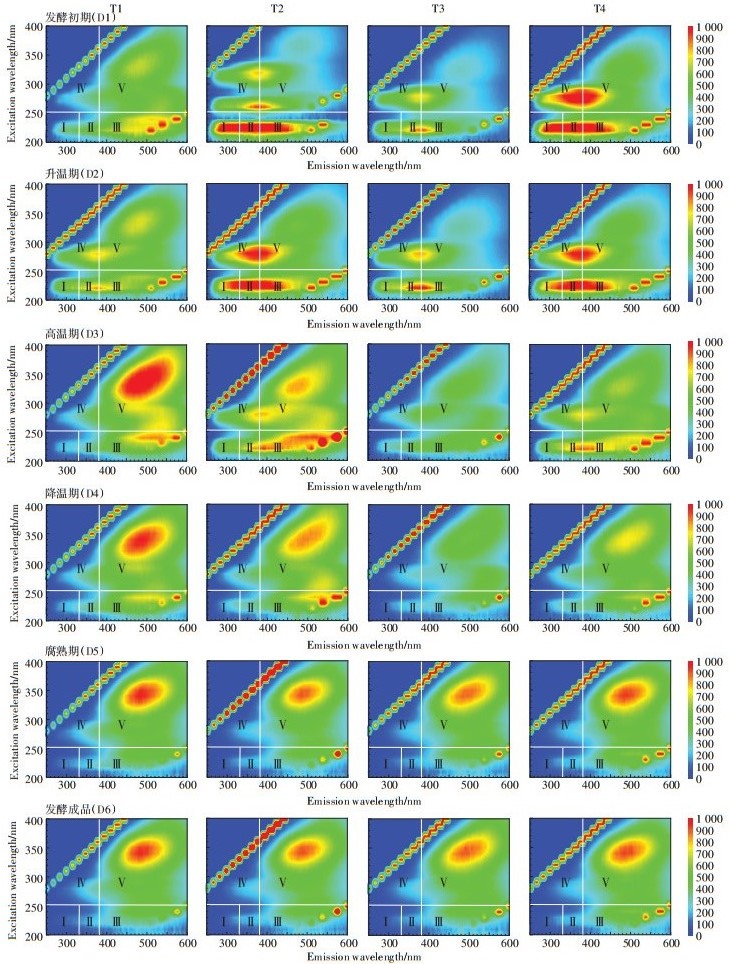
|
图 2 好氧发酵过程中水溶性有机物(DOM)的三维荧光光谱图 Figure 2 Three-dimensional fluorescence spectrum of dissolved organic matter(DOM)during aerobic fermentation |
各个区域荧光积分占比分布如图 3所示。发酵初期,猪粪原料中的蛋白质、氨基酸类物质尚未开始大量分解[31],类氨基酸物质占比较高,为9.86%~ 20.86%,微生物降解产物占比为4.96%~14.28%,其中T4处理中这两类物质占比最高,原因是大量的生物炭促进了发酵过程中的微生物活动,加速了有机物降解[32]。升温期,腐殖质类物质开始增加,类酪氨酸物质占荧光类物质的百分比降为5.16%~7.71%,类色氨酸物质略有降低,可溶性微生物降解产物逐渐分解,占比降为9.69%~12.87%,类富里酸和类胡敏酸物质占比增至21.34%~23.24%和44.40%~55.41%,其中T1处理所占比值最大,明显高于添加生物炭的处理。进入高温期后,微生物代谢活性明显增强,蛋白质类物质迅速分解,可溶性微生物降解导致区Ⅰ、区Ⅱ和区Ⅳ占比大幅下降[33],腐殖质类物质大量出现,除T1处理外,其他处理的类富里酸所占比例均达到最高。T1、T2、T3和T4处理类胡敏酸物质所占比例分别增至68.12%、57.60%、58.32% 和54.15%。降温期,类胡敏酸物质占比持续增加,类富里酸物质开始降低。腐熟期,不稳定的有机质几乎被微生物完全降解,各区域占比无明显变化,类富里酸物质占比保持在20% 左右,与TIAN等[34]的研究结果一致,各处理荧光区域积分得到的结果也与E4/E6的变化规律保持一致。
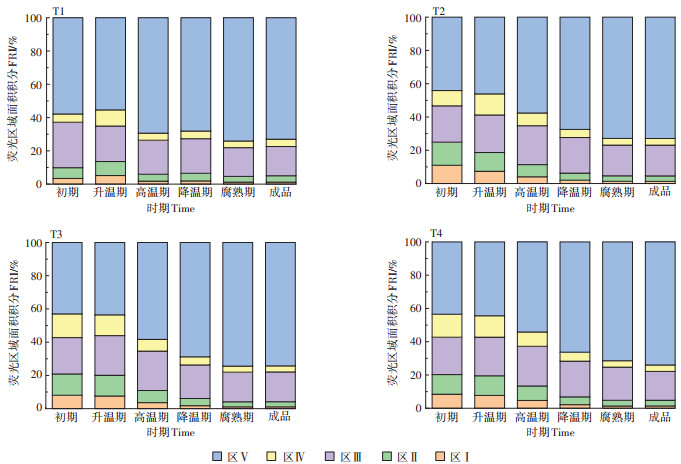
|
图 3 荧光区域积分的占比分布图 Figure 3 Distribution of the proportion of the fluorescence area integration |
生物炭的添加为好氧发酵过程中微生物提供更好的生长环境[35],使蛋白类物质被大量分解,有机质芳香性降低,芳环上含氧基团含量增加,生成更加稳定的类富里酸和胡敏酸物质[36],为重金属提供更多稳定的结合位点[37-38]。T1、T2、T3和T4的腐殖质类物质较发酵前分别增加了22.69%、24.49%、25.32% 和25.45%,HA/FA值分别为4.07、3.94、4.22和4.27,其中FA水溶性较高,HA能更稳定地吸附固定重金属,比值增大对降低发酵原料中重金属的迁移性具有重要意义[39],同时,腐殖质可作为重金属离子的载体,使其更快速、高效地与生物炭接触而被吸附,降低迁移速率[40-41]。
2.3 重金属总量和形态变化猪粪好氧发酵后重金属含量升高,整体表现为“相对浓缩效应”[42],发酵后重金属含量变化如表 4所示。
|
|
表 4 好氧发酵后重金属总量增长的百分比(%) Table 4 Percentage of total heavy metal growth after aerobic fermentation(%) |
Cu的形态变化如图 4a所示,发酵结束后T1、T2、T3和T4处理的可交换态(EXCH)Cu占比分别降低了3.79%、7.76%、6.09%和6.53%;还原态(RF)Cu变化趋势不明显;氧化态(OF)Cu均有不同程度的升高;残渣态(RESI)Cu均有所增加,发酵后占比升高了4.21%~ 9.12%。Zn的形态变化如图 4b所示,发酵结束后T1、T2、T3和T4处理的可交换态Zn分别降低了6.50%、4.77%、9.39% 和8.30%;还原态Zn与交换态Zn的变化趋势大致相同;氧化态Zn占比分别增加了15.10%、6.32%、8.69%和2.39%;残渣态Zn无明显变化。Cd的形态变化如图 4c所示,发酵后T1、T2、T3和T4处理的可交换态Cd占比分别降低了4.47%、8.27%、6.85%和7.82%,其他形态Cd占比均有所上升,其中还原态Cd增加最为明显。Pb的形态变化如图 4d所示,发酵结束后T1、T2、T3和T4处理的可交换态Pb占比分别降低了3.06%、1.22%、4.37% 和3.50%;还原态Pb占比呈现先降低后升高的趋势;氧化态Pb较发酵前分别变化了-6.11%、2.86%、3.77%、4.42%;残渣态整体变化不明显。
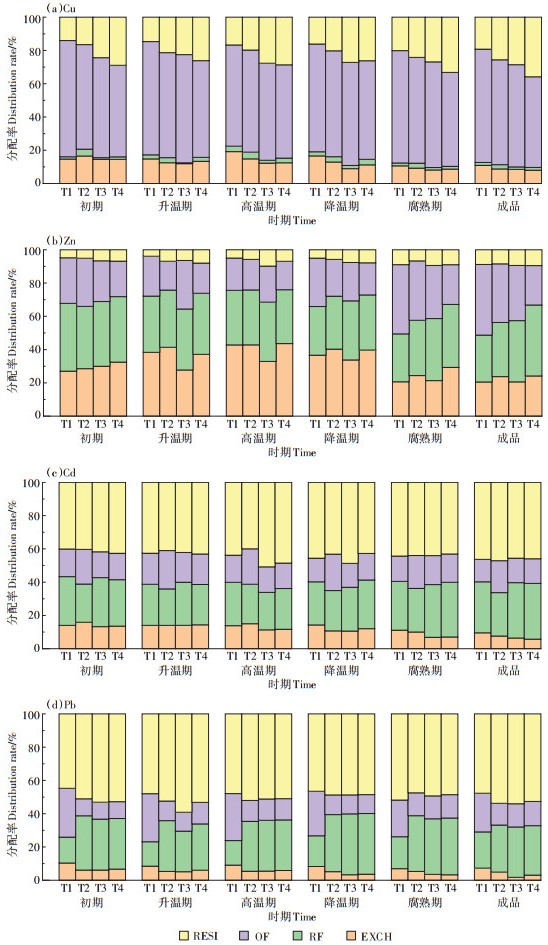
|
图 4 好氧发酵过程中Cu、Zn、Cd、Pb形态分配率 Figure 4 The distribution of Cu, Zn, Cd, Pb in composting process |
各处理重金属Cu、Zn、Cd、Pb的钝化效率如表 5所示,总体来看,添加生物炭的处理重金属钝化效率有较大提升,能够促进活性相对较高的吸附态重金属向着较为稳定的络合态和沉淀态转化[43]。
|
|
表 5 各处理重金属的钝化效率(%) Table 5 The passivation efficiency of heavy metals in each treatment (%) |
发酵过程中重金属形态变化受到DOM组分、理化性质和生物炭添加量等影响,将猪粪好氧发酵过程中的DOM组分变化、温度、pH、EC、含水率、生物炭添加比例和Cu、Zn、Cd和Pb各形态含量进行相关性分析,其结果如表 6所示。
|
|
表 6 理化性质和荧光区域积分与重金属可交换态的相关系数 Table 6 Correlation coefficients between physicochemical properties and FRI of the five regions decomposition for heavy metals of exchange |
相关性分析结果表明,可交换态Cu、Zn、Cd、Pb均与类富里酸物质呈显著正相关,与类胡敏酸物质呈显著负相关,除Zn外均与类酪氨酸、类色氨酸和可溶性微生物降解产物呈显著正相关;还原态Cd和Pb与类富里酸、类酪氨酸物质和可溶性微生物降解产物呈显著负相关,与类胡敏酸物质呈显著正相关;氧化态Zn与类富里酸和可溶性微生物降解产物呈显著负相关,与类胡敏酸物质呈显著正相关;残渣态Zn、Cd、Pb与类酪氨酸和类色氨酸均呈显著负相关,与类胡敏酸物质呈显著正相关。发酵过程中,DOM组分中水溶性小分子量的FA向固相大分子量的HA转化[44],其含量、结构和官能团均发生改变,对重金属形态的影响较为显著,其中HA的羧基、酚羟基等对重金属的络合起主要作用[45]。
温度与可交换态的Cu、Zn、Cd均呈显著正相关,发酵过程中有机物质分解伴随着热量的快速释放,进而加快了生物炭表面阳离子释放,一定程度上促进其与重金属离子的交换反应。pH与可交换态的Cu、Zn、Cd、Pb均呈显著负相关,pH对重金属形态变化有较大影响,pH上升,提高了腐殖质的键合能力及重金属配合物的稳定性[46],可促进重金属发生离子交换、表面吸附、共沉淀等反应,此外,pH与HA呈显著正相关,与其他的DOM含量变化呈显著负相关。HE等[47]研究发现HA与重金属离子形成的络合物受pH影响显著,随着pH上升,络合能力增强,同时与羟基等结合形成的沉淀物更加稳定[48]。含水率和EC变化均与可交换态Cu、Cd、Pb的分配率呈显著正相关,说明发酵过程中在物料含水率和离子活性较高的情况下重金属的迁移和生物有效性均有所提升。
3 结论(1)好氧发酵过程中添加生物炭后,pH、含水率、EC和GI等均满足无害化和腐熟化标准,提高了腐殖质类物质含量,促进了FA向HA的转化。
(2)不同生物炭添加量处理对重金属Cu、Zn、Pb、Cd的钝化效果不同,但均能使活性相对较高的吸附态向着较为稳定的络合态和沉淀态转化。
(3)DOM组分中FA和HA对可交换态Cu、Zn、Cd和Pb的影响显著,其中HA对重金属的络合起主要作用;温度、pH、EC和含水率的变化均对可交换态Cu、Zn、Cd和Pb有不同程度的影响。
| [1] |
BOLAN N, ADRIANO D, MAHIMAIRAJA S. Distribution and bioavailability of trace elements in livestock and poultry manure by-products[J]. Critical Reviews in Environmental Science & Technology, 2004, 34(3): 291-338. |
| [2] |
贾武霞, 文炯, 许望龙, 等. 我国部分城市畜禽粪便中重金属含量及形态分布[J]. 农业环境科学学报, 2016, 35(4): 764-773. JIA W X, WEN J, XU W L, et al. Content and fractionation of heavy metals in livestock manures in some urban areas of China[J]. Journal of Agro-Environment Science, 2016, 35(4): 764-773. |
| [3] |
闫秋良, 刘福柱. 通过营养调控缓解畜禽生产对环境的污染[J]. 家畜生态学报, 2002, 23(3): 68-70. YAN Q L, LIU F Z. Reduction environmental pollution of animal production by adjustment of nutrition[J]. Ecology of Domestic Animal, 2002, 23(3): 68-70. DOI:10.3969/j.issn.1673-1182.2002.03.024 |
| [4] |
王飞, 赵立欣, 沈玉君, 等. 华北地区畜禽粪便有机肥中重金属含量及溯源分析[J]. 农业工程学报, 2013, 29(19): 202-208. WANG F, ZHAO L X, SHEN Y J, et al. Analysis of heavy metal contents and source tracing in organic fertilizer from livestock manure in north China[J]. Transactions of the Chinese Society of Agricultural Engineering, 2013, 29(19): 202-208. DOI:10.3969/j.issn.1002-6819.2013.19.025 |
| [5] |
侯月卿, 沈玉君, 刘树庆. 我国畜禽粪便重金属污染现状及其钝化措施研究进展[J]. 中国农业科技导报, 2014, 16(3): 112-118. HOU Y Q, SHEN Y J, LIU S Q. Present status of heavy metal pollution from livestock waste and progress on passivation measures[J]. Journal of Agricultural Science and Technology, 2014, 16(3): 112-118. |
| [6] |
熊雄, 李艳霞, 韩杰, 等. 堆肥腐殖质的形成和变化及其对重金属有效性的影响[J]. 农业环境科学学报, 2008, 27(6): 2137-2142. XIONG X, LI Y X, HAN J, et al. Formation and transformation of humus in composting and its impacts on bioavailability of toxic metals[J]. Journal of Agro-Environment Science, 2008, 27(6): 2137-2142. DOI:10.3321/j.issn:1672-2043.2008.06.003 |
| [7] |
KOZYATNYK I, BOUCHET S, BJORN E, et al. Fractionation and size-distribution of metal and metalloid contaminants in a polluted groundwater rich in dissolved organic matter[J]. Journal of Hazardous Materials, 2016, 318: 194-202. DOI:10.1016/j.jhazmat.2016.07.024 |
| [8] |
RIEDEL T, BIESTER H, DITTMAR T. Molecular fractionation of dissolved organic matter with metal salts[J]. Environ Sci Technol, 2012, 46(8): 4419-4426. DOI:10.1021/es203901u |
| [9] |
HUANG M, LI Z W, HUANG B, et al. Investigating binding characteristics of cadmium and copper to DOM derived from compost and rice straw using EEM-PARAFAC combined with two-dimensional FTIR correlation analyses[J]. Journal of Hazardous Materials, 2018, 344: 539-548. DOI:10.1016/j.jhazmat.2017.10.022 |
| [10] |
SHEN Y J, ZHAO L X, MENG H B, et al. Effect of aeration rate, moisture content and composting period on availability of copper and lead during pig manure composting[J]. Waste Management & Research, 2016, 34(6): 578-583. |
| [11] |
BROWN S, CHANEY R, HALLFRISCH J, et al. In situ soil treatments to reduce the phyto-and bioavailability of lead, zinc, and cadmium[J]. Journal of Environment Quality, 2004, 33(2): 522-531. DOI:10.2134/jeq2004.5220 |
| [12] |
毛晖, 李荣华, 黄懿梅, 等. 添加剂对猪粪好氧堆肥过程锌和铜形态的影响[J]. 农业机械学报, 2013, 44(10): 164-171. MAO H, LI R H, HUANG Y M, et al. Effect of additives on forms of Zn and Cu during aerobic composting of pig manure[J]. Transactions of the Chinese Society of Agricultural Machinery, 2013, 44(10): 164-171. DOI:10.6041/j.issn.1000-1298.2013.10.026 |
| [13] |
杨坤, 李军营, 杨宇虹, 等. 不同钝化剂对猪粪堆肥中重金属形态转化的影响[J]. 中国土壤与肥料, 2011(6): 43-48. YANG K, LI J Y, YANG Y H, et al. Effect of passivator on form transformation of heavy metal in composting of pig manure[J]. Soils and Fertilizers Sciences in China, 2011(6): 43-48. DOI:10.3969/j.issn.1673-6257.2011.06.008 |
| [14] |
ZHOU H B, MENG H B, ZHAO L X, et al. Effect of biochar and humic acid on the copper, lead, and cadmium passivation during composting[J]. Bioresource Technology, 2018, 258: 279-286. DOI:10.1016/j.biortech.2018.02.086 |
| [15] |
LI R, MENG H B, ZHAO L X, et al. Study of the morphological changes of copper and zinc during pig manure composting with addition of biochar and a microbial agent[J]. Bioresource Technology, 2019, 291: 121752. DOI:10.1016/j.biortech.2019.121752 |
| [16] |
刘甜田, 何滨, 王亚韩, 等. 改进BCR法在活性污泥样品重金属形态分析中的应用[J]. 分析试验室, 2007, 26(增刊1): 17-20. LIU T T, HE B, WANG Y H, et al. Application of improved BCR method in the speciation analysis of heavy metals in activated sludge samples[J]. Chinese Journal of Analysis Laboratory, 2007, 26(Suppl 1): 17-20. |
| [17] |
肖骁, 何小松, 高如泰, 等. 垃圾填埋有色溶解性有机质与铜络合机制[J]. 环境科学, 2017, 38(5): 1873-1880. XIAO X, HE X S, GAO R T, et al. Complexation between copper(Ⅱ)and colored dissolved organic matter from municipal solid waste landfill[J]. Environmental Science, 2017, 38(5): 1873-1880. |
| [18] |
沈玉君, 李国学, 任丽梅, 等. 不同通风速率对堆肥腐熟度和含氮气体排放的影响[J]. 农业环境科学学报, 2010, 29(9): 1814-1819. SHEN Y J, LI G X, REN L M, et al. The impact of composting with different aeration rates on maturity variation and emission of gas concluding N[J]. Journal of Agro - Environment Science, 2010, 29(9): 1814-1819. |
| [19] |
WANG Q, AWASTHI M, REN X N, et al. Combining biochar, zeolite and wood vinegar for composting of pig manure: The effect on greenhouse gas emission and nitrogen conservation[J]. Waste Management, 2018, 74: 221-230. DOI:10.1016/j.wasman.2018.01.015 |
| [20] |
WONG J, WANG X, SELVAM A. Improving compost quality by controlling nitrogen loss during composting[J]. Current Developments in Biotechnology & Bioengineering, 2017, 59-82. |
| [21] |
WANG Q, AWASTHI M, ZHAO J C, et al. Improvement of pig manure compost lignocellulose degradation, organic matter humification and compost quality with medical stone[J]. Bioresource Technology, 2017, 243: 771-777. DOI:10.1016/j.biortech.2017.07.021 |
| [22] |
LI R H, WANG Q, ZHANG Z Q, et al. Nutrient transformation during aerobic composting of pig manure with biochar prepared at different temperatures[J]. Environmental Technology, 2015, 36(7): 815-826. DOI:10.1080/09593330.2014.963692 |
| [23] |
YUAN J, CHADWICK D, ZHANG D F, et al. Effects of aeration rate on maturity and gaseous emissions during sewage sludge composting[J]. Waste Management, 2016, 56: 403-410. DOI:10.1016/j.wasman.2016.07.017 |
| [24] |
YUAN J, LI Y, CHEN S L, et al. Effects of phosphogypsum, superphosphate, and dicyandiamide on gaseous emission and compost quality during sewage sludge composting[J]. Bioresource Technology, 2018, 270: 368-376. DOI:10.1016/j.biortech.2018.09.023 |
| [25] |
鲍艳宇, 颜丽, 娄翼来, 等. 鸡粪堆肥过程中各种碳有机化合物及腐熟度指标的变化[J]. 农业环境科学学报, 2005, 24(4): 820-824. BAO Y Y, YAN L, LOU Y L, et al. Dynamics of organic carbons during composting of chicken manure and evaluation of maturity parameters[J]. Journal of Agro-Environment Science, 2005, 24(4): 820-824. DOI:10.3321/j.issn:1672-2043.2005.04.046 |
| [26] |
LI H H, ZHANG T, TSANG D, et al. Effects of external additives: Biochar, bentonite, phosphate, on co-composting for swine manure and corn straw[J]. Chemosphere, 2020, 248: 125927. DOI:10.1016/j.chemosphere.2020.125927 |
| [27] |
宋彩红, 贾璇, 李鸣晓, 等. 沼渣与畜禽粪便混合堆肥发酵效果的综合评价[J]. 农业工程学报, 2013, 29(24): 227-234. SONG C H, JIA X, LI M X, et al. Comprehensive evaluation of co-composting fermentation effect of biogasresidue mixed with livestock manure[J]. Transactions of the Chinese Society of Agricultural Engineering, 2013, 29(24): 227-234. DOI:10.3969/j.issn.1002-6819.2013.24.030 |
| [28] |
HE X S, XI B D, WEI Z M, et al. Spectroscopic characterization of water extractable organic matter during composting of municipal solid waste[J]. Chemosphere, 2011, 82(4): 541-548. DOI:10.1016/j.chemosphere.2010.10.057 |
| [29] |
李丹, 何小松, 席北斗, 等. 生活垃圾堆肥渗滤液污染物组成与演化规律研究[J]. 环境科学, 2013, 34(7): 2918-2924. LI D, HE X S, XI B D, et al. Composition and transformation of leachates during municipal solid waste composting[J]. Environmental Science, 2013, 34(7): 2918-2924. |
| [30] |
何小松, 刘晓宇, 魏东, 等. 荧光光谱研究垃圾堆场渗滤液水溶性有机物与汞作用[J]. 光谱学与光谱分析, 2009, 29(8): 2204-2207. HE X S, LIU X Y, WEI D, et al. Fluorescence spectroscopic characterization of the complexation between mercury(Ⅱ)and dissolved organic matter[J]. Spectroscopy and Spectral Analysis, 2009, 29(8): 2204-2207. DOI:10.3964/j.issn.1000-0593(2009)08-2204-04 |
| [31] |
唐朱睿, 席北斗, 何小松, 等. 猪粪堆肥过程中水溶性有机物结构演变特征[J]. 光谱学与光谱分析, 2018, 38(5): 1526-1532. TANG Z R, XI B D, HE X S, et al. Structural characteristics of dissolved organic compounds during swine manure composting[J]. Spectroscopy and Spectral Analysis, 2018, 38(5): 1526-1532. |
| [32] |
ZHANG S H, CHEN Z Q, WEN Q X, et al. Assessment of maturity during co-composting of penicillin mycelial dreg via fluorescence excitation-emission matrix spectra: Characteristics of chemical and fluorescent parameters of water-extractable organic matter[J]. Chemosphere, 2016, 155: 358-366. DOI:10.1016/j.chemosphere.2016.04.051 |
| [33] |
孙向平. 不同控制条件下堆肥过程中腐殖质的转化机制研究[D]. 北京: 中国农业大学, 2013: 53-70. SUN X P. The humuns transformation mechanism research during composting under different controlled conditions[D]. Beijing: China Agriculture University, 2013: 53-70. |
| [34] |
TIAN W, LI L Z, LIU F, et al. Assessment of the maturity and biological parameters of compost produced from dairy manure and rice chaff by excitation – emission matrix fluorescence spectroscopy[J]. Bioresource Technology, 2012, 110: 330-337. DOI:10.1016/j.biortech.2012.01.067 |
| [35] |
CARSON J K, CAMPBELL L, ROONEY D, et al. Minerals in soil select distinct bacterial communities in their microhabitats[J]. FEMS Microbiology Ecology, 2009, 67(3): 381-388. DOI:10.1111/j.1574-6941.2008.00645.x |
| [36] |
GUO X J, LI C W, ZHU Q L, et al. Characterization of dissolved organic matter from biogas residue composting using spectroscopic techniques[J]. Waste Management, 2018, 78: 301-309. DOI:10.1016/j.wasman.2018.06.001 |
| [37] |
HE X S, XI B D, WEI Z M, et al. Spectroscopic characterization of water extractable organic matter during composting of municipal solid waste[J]. Chemosphere, 2011, 82(4): 541-548. DOI:10.1016/j.chemosphere.2010.10.057 |
| [38] |
崔东宇, 何小松, 席北斗, 等. 堆肥腐熟前后胡敏酸与富里酸的还原容量比较[J]. 中国环境科学, 2015, 35(7): 2087-2094. CUI D Y, HE X S, XI B D, et al. The comparison of reduction capacity between humic acid and fulvic acid extracted from the compost[J]. China Environmental Science, 2015, 35(7): 2087-2094. DOI:10.3969/j.issn.1000-6923.2015.07.028 |
| [39] |
HSU J, LO S. Chemical and spectroscopic analysis of organic matter transformations during composting of pig manure[J]. Environmental Pollution, 1999, 104(2): 189-196. DOI:10.1016/S0269-7491(98)00193-6 |
| [40] |
张雪英, 周顺桂, 周立祥, 等. 堆肥处理对污泥腐殖物质形态及其重金属分配的影响[J]. 生态学杂志, 2004, 23(1): 30-33. ZHANG X Y, ZHOU S G, ZHOU L X, et al. Component changes of humic substances and heavy metal distribution before and after sewage sludge composting[J]. Chinese Journal of Ecology, 2004, 23(1): 30-33. DOI:10.3321/j.issn:1000-4890.2004.01.007 |
| [41] |
HE X S, XI B D, PAN H W, et al. Characterizing the heavy metalcomplexing potential of fluorescent water-extractable organic matter from composted municipal solid wastes using fluorescence excitation– emission matrix spectra coupled with parallel factor analysis[J]. Environmental Science and Pollution Research, 2014, 21(13): 7973-7984. DOI:10.1007/s11356-014-2751-9 |
| [42] |
LU D A, WANG L X, YAN B X, et al. Speciation of Cu and Zn during composting of pig manure amended with rock phosphate[J]. Waste Management, 2014, 34(8): 1529-1536. DOI:10.1016/j.wasman.2014.04.008 |
| [43] |
HE M M, TIAN G, LIANG X Q. Phytotoxicity and speciation of copper, zinc and lead during the aerobic composting of sewage sludge[J]. Journal of Hazardous Materials, 2009, 163(2): 671-677. |
| [44] |
TANG W W, ZENG G M, GONG J L, et al. Simultaneous adsorption of atrazine and Cu(Ⅱ)from wastewater by magnetic multi-walled carbon nanotube[J]. Chemical Engineering Journal, 2012, 211: 470-478. |
| [45] |
HUR J, LEE B. Characterization of binding site heterogeneity for copper within dissolved organic matter fractions using two-dimensional correlation fluorescence spectroscopy[J]. Chemosphere, 2011, 83(11): 1603-1611. DOI:10.1016/j.chemosphere.2011.01.004 |
| [46] |
AWASTHI S, LIU T, AWASTHI M, et al. Evaluation of biochar amendment on heavy metal resistant bacteria abundance in biosolids compost[J]. Bioresource Technology, 2020, 306: 123114. DOI:10.1016/j.biortech.2020.123114 |
| [47] |
HE M M, LI W H, LIANG X Q, et al. Effect of composting process on phytotoxicity and speciation of copper, zinc and lead in sewage sludge and swine manure[J]. Waste Management, 2009, 29(2): 590-597. DOI:10.1016/j.wasman.2008.07.005 |
| [48] |
ZENG Z Z, WANG X L, GOU J F, et al. Effects on Ni and Cd speciation in sewage sludge during composting and co-composting with steel slag[J]. Waste Management & Research, 2014, 32(3): 179-185. |
 2021, Vol. 40
2021, Vol. 40








